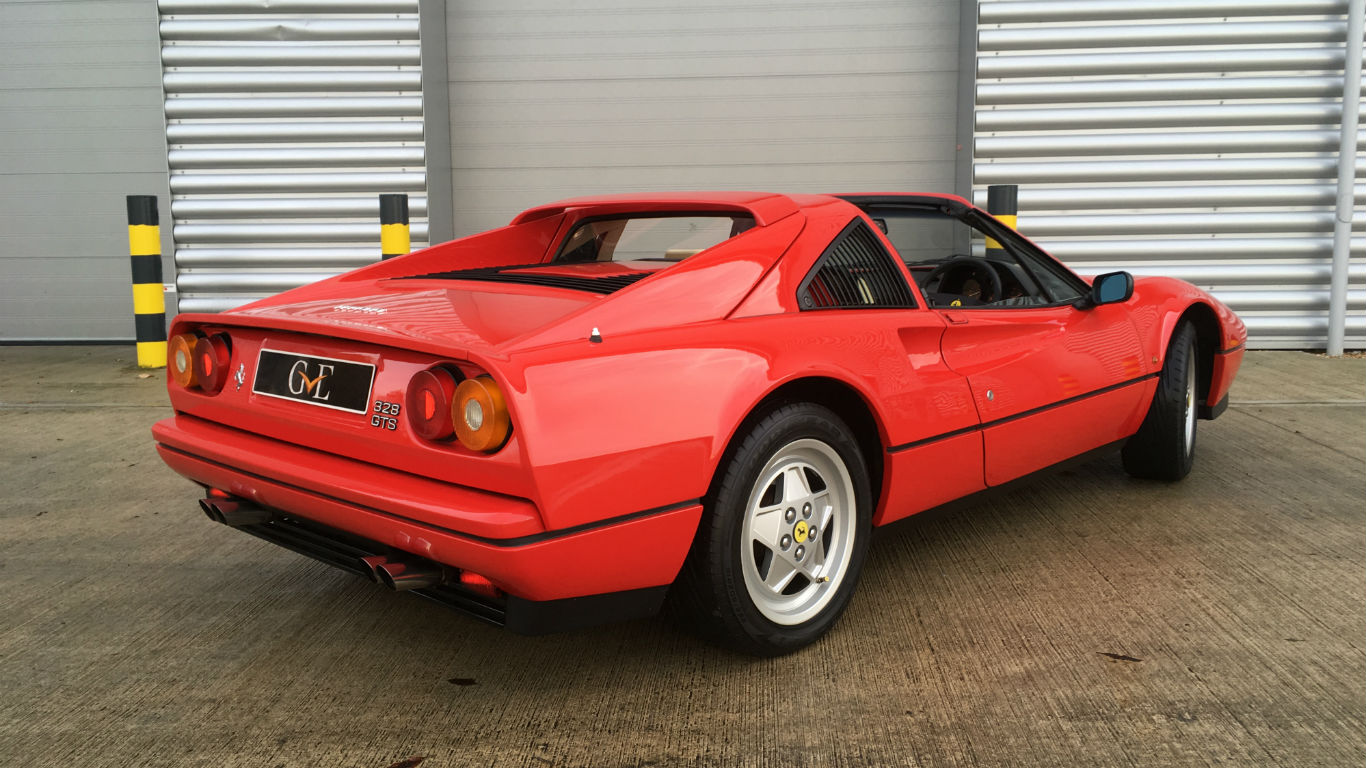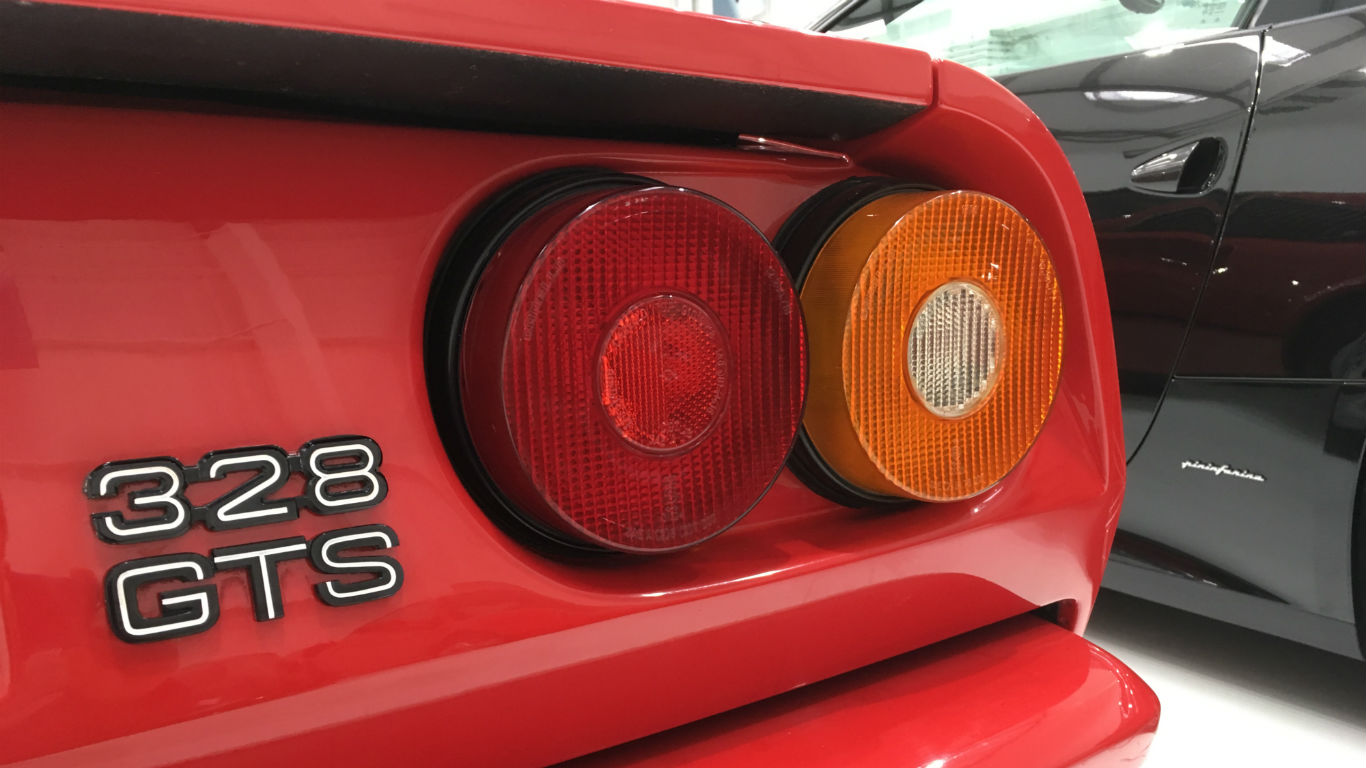We’ve covered a lot of bases in these reviews, from a £2,000 Skoda to a £200,000 Porsche. But we’d never driven a classic Ferrari… until now. Welcome to a Retro Road Test special.
The Ferrari in question is a 328: the entry-point to the marque’s mid-1980s range, alongside the Mondial, Testarossa, 412 and – latterly – F40. Thirty five years on, it remains one of the most beautiful ‘modern’ Ferraris – and potentially one of the most sensible, too.

This 1988 328 is a targa-topped GTS (Gran Turismo Spider), kindly loaned to us by GVE London. It has now been sold, but you can see the company’s current stock here.
What are its rivals?

If you were shopping for a new Ferrari 296 GTS today, you might also look at the McLaren Artura, Lamborghini Huracan, Audi R8, Maserati MC20 or Porsche 911 Turbo S, among others.
Back in 1988, supercar buyers weren’t so spoilt for choice. The 328 had just three rivals: the Lamborghini Jalpa, Lotus Esprit and Porsche 930 Turbo. Oh, and the De Tomaso Pantera, if you really must.
Perhaps the most obvious alternative today is the original Honda NSX. Launched in 1990, the NSX has an identical power output to the 328 and shares its mid-engined layout, wedgy profile and cockpit-style cabin. It’s a sharper drive – and cheaper to buy, too. But it doesn’t have a prancing horse on the bonnet.
Which engine does it use?

Fire up this mid-mounted V8 and there are no theatrical throttle blips or showboating exhaust pops. Only when you approach its lofty 7,700rpm redline does this engine sound special. Well, needs must…
The 328 uses a 3.2-litre development of the 3.0 quattrovalvole (four-valve-per-cylinder) V8 from the Ferrari 308. Maximum power is 274hp at 7,000rpm, while peak torque is 224lb ft at 5,500rpm.
In a car weighing a modest 1,325kg, that’s sufficient for 0-60mph in 5.5 seconds and a top speed of around 160mph.
What’s it like to drive?
Ferrari’s open-gate manual gearbox looks timelessly cool, but it certainly needs some muscle – especially when cold. I’m advised to short-shift from first to third until the oil is warmed-up. However, I immediately fail by forgetting first gear is on a dog-leg: down and left, where reverse might usually be. Forget your click-click flappy paddles, this car demands deliberate, decisive inputs.
The same goes for the unassisted steering, which is heavy at low speeds, and the engine, which demands to be kept on the boil. The brakes are far better than most cars of this era, though, despite the pedals being ridiculously skewed towards the centre of the car.
On damp winter tarmac, I won’t pretend I pushed the 328 too close to its limits. But I did escape the London suburbs and find some quiet lanes, stowing the targa top behind the seats (a two-minute job, incidentally) and relishing the rasp of the V8 as it bounced off the hedgerows.
It took a while, but here the Ferrari and I had a meeting of minds. Its gorgeous Momo steering wheel danced in my hands as we dived through a series of bends, poised and precise. If offers no electronic safety nets, and thus no excuses. Driving a 328 is physical, cerebral and utterly analogue – and all the better for it.
Reliability and running costs

The 328 is considered one of the most reliable classic Ferraris. An evolution of the 308, launched in 1975, it’s a relatively simple car, free from electronic wizardry. Bosch K-Jetronic mechanical fuel injection was the order of the day here.
Unlike many Ferraris, a 328 can be serviced without removing the engine, which keeps servicing costs down. You should still set aside a few thousand pounds a year, though.
Fuel economy is quoted as 22.5mpg at a constant 56mph – and probably low teens if you give the car a workout. Still, look after your 328 and it should be an appreciating asset. With luck, that rise in value could outweigh the running costs altogether.
Could I drive it every day?

In theory, yes. Amazingly, the 328 is shorter and narrower than a current Ford Focus, so it’s compact enough to feel nimble in the city. That’s not something you could say about the wide-boy Testarossa, or indeed the majority of 21st century supercars.
Ride quality is better than modern machines, too – thank absorbent 55-profile tyres – and the 328 has enough luxuries (air-con, electric windows and, er, a cassette player) to be comfortable on longer journeys. It feels like a sports car built for the road, rather than the racetrack.
The big question, of course, is should you drive it every day? There, the answer is probably ‘no’. The rising value of 328s dictates that most owners want to keep wear and mileage to a minimum. And on that note…
How much should I pay?

The 308 GTS was built in large numbers for a Ferrari. In total, 6,068 left Maranello, versus 1,344 for the hard-top GTB.
Prices vary widely depending on mileage and condition. The cheapest UK-based GTS at the time of writing was a right-hand-drive car with 50,000 miles for £62,000. At the other end of the scale, a GTS with a scant 574 miles on the clock was advertised at £180,000.
What should I look out for?

We asked GVE owner David Rai (pictured) and the company’s former Ferrari expert, Guy Tedder, what to look for when buying a Ferrari 328. These were their top five tips:
- As with all Ferraris, service history is of paramount importance. Originality is vital with older cars, too.
- Don’t be scared off by service stamps from a specialist; they can be a better bet than Ferrari main dealers, who don’t necessarily know much about the classic models.
- All 328s had a galvanised body, so rust problems aren’t a big issue. However, check the bottoms of the doors and the back of the rear wheelarches for possible corrosion.
- Windows can become slow and shuddery through lack of use. This can be rectified by lubricating the moving parts inside the door.
- Always check that the air conditioning works efficiently. It wasn’t the most well-designed system in the world, and most cars have been converted to new gas by now.
Should I buy one?

The Pininfarina-penned 328 is an object of beauty. I had one on my bedroom wall as a child and, unlike yours truly, it has only grown lovelier with age.
It isn’t particularly quick by modern standards (a Mercedes-AMG A45 S would leave it for dust), but that hardly matters. The Ferrari offers a driving experience that’s immersive, invigorating and intoxicating. It’s a car you’ll want to learn more about: to discover its abilities by developing your own. It isn’t perfect, but the quirks are all part of its character.
For the price of a nice 328 GTS, you could buy a new Porsche 911 Carrera, a car that is, objectively, better in every way. But that is missing the point. The Ferrari is a car to be enjoyed on sunny Sunday mornings and special occasions. And it’s a potential investment, too.
Pub fact

Ferrari built 542 UK right-hand-drive examples of the 328 GTS between 1986 and 1989. Of these, 292 had anti-lock (ABS) brakes.
According to Guy Tedder, ABS models are slightly less desirable due to revised suspension geometry that made the car feel less responsive. Such cars are easily identified by their convex alloy wheels. Non-ABS cars have concave alloys.
ALSO READ:
1993 Vauxhall Lotus Carlton review: Retro Road Test
Peel P50: driving the world’s smallest car
Lancia Thema 8.32: the sensible saloon with a Ferrari engine


